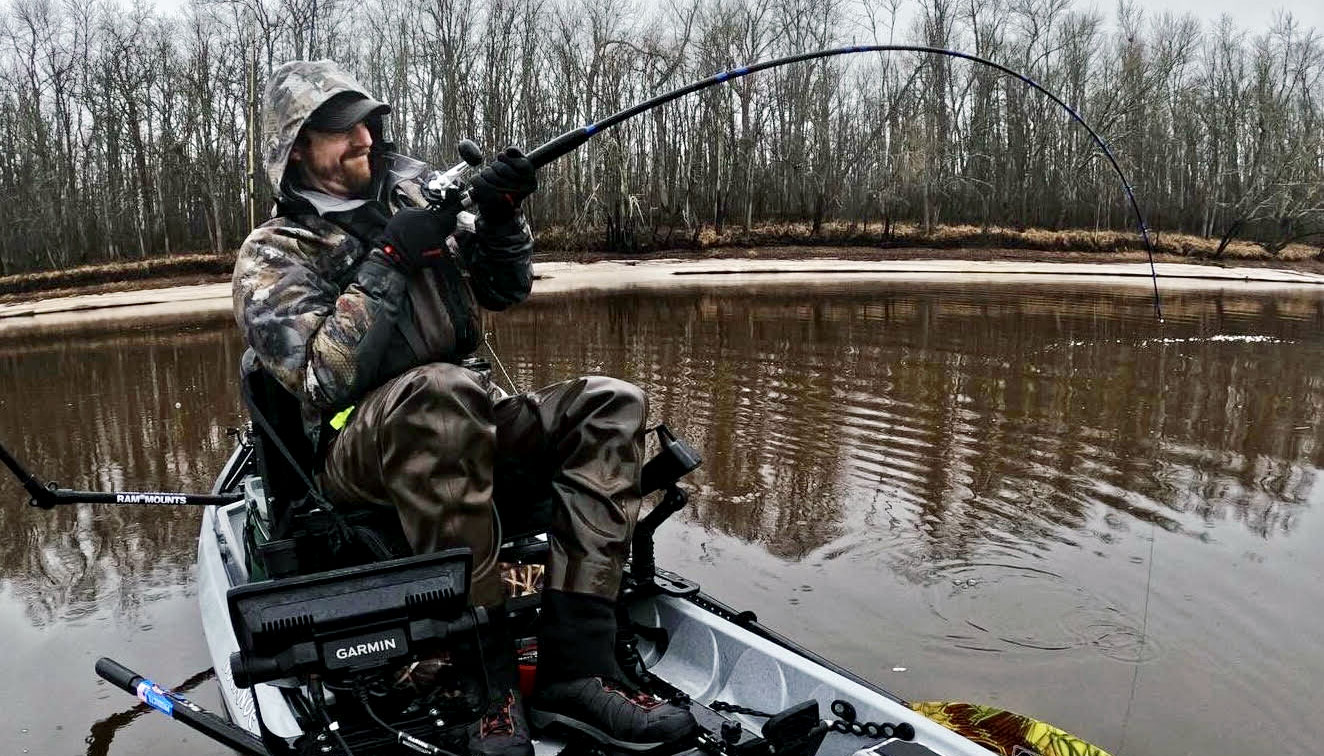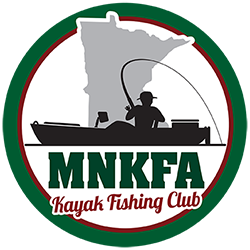
By Eric Scrivner
Hooking into a sturgeon from a kayak is a ridiculously fun experience, and we have some of the best lake sturgeon fisheries in the country here in Minnesota with the Rainy River and the St. Croix River. While the biggest of these prehistoric fish, including the MN state records, have historically come from the St Croix River and its tributaries, you’d be hard pressed to find a place where you can catch the numbers of big sturgeon that you can find on the Rainy River.
Tackling a sturgeon from a kayak might be intimidating, but the fishing itself is really simple, and I’ve tried to break it down the best I can so others might try to get up there and take a shot at hooking one (or several) of these dinosaurs.
Gear: I use a dedicated sturgeon/catfish setup with a heavy duty levelwind reel and 100 lb braid
But if you’ve got a musky rod or even a stout swimbait or frog rod with 65 lb braid it’ll work just fine. Heavier catfish rods, like a flathead catfish setup, are a perfect option. You’re looking for a rod with a soft tip but plenty of backbone—they’re huge fish, but the bite is incredibly light. For tackle, I basically use a version of a Carolina rig: I put a sinker slide on the braid mainline above a swivel, then connect a 12-18” leader of 30-50 lb monofilament to a 8/0 octopus circle hook. The mono is necessary in case they roll on the line, you don’t want the fish to get cut up from braid, and the circle hooks are really good at hooking these fish right in the corner of the mouth—no swallowed hooks, no foul-hooked fish, and very easy to unhook. If you’re around smaller fish you can size down as far as a 5/0 circle hook, but small sturgeon have no problem eating an 8/0 hook, and you’ll want the more robust hook for those 50+ pound fish. Sinker slides are optional but I’m typically using 4-8 oz of weight, depending on current, and I like to be able to easily change weights without re-tying and also remove the weight for transporting rods.

Bait: nightcrawlers.
You can also buy frozen emerald shiners and use a combo of shiners and crawlers, but I’ve never noticed a difference so I just use crawlers. Bring lots, an 8/0 circle hook will hold 3-5 crawlers and if the suckers and walleyes are around you’ll have to re-bait frequently.
Where to fish: find a deeper hole, most of the fish seem to hang out in 7-18 feet of water, but I’ve caught them as shallow as 2 feet and as deep as 30 feet.
You’ll often see sturgeon breaching the surface in areas with lots of fish—they’re not surface feeding when they do this, they’re forcing air into their swim bladder to control their buoyancy. Anchor or spot lock at the front end (upstream side) of the hole and fish downstream of your position, either straight back or up to 45 degrees to either side. If you fish at an upstream angle greater than 45 degrees you won’t feel a lot of bites because of the drag on your line from the current. You don’t need to cast far, a typical cast is about 30-40 feet or less.
The bite: these are huge fish but have the softest bite you’ll ever feel.
If you feel a sharp rap on your line, it’s probably a sucker or a walleye, but if you just feel gentle tugging, or just feel a change in the weight on your line, lift gently on the rod to see if there’s tension. When a fish is there, you’ll feel like you’re snagged on a rock, then the “rock” will start shaking its head and swimming away.
The hook set: if you’ve never used circle hooks, you need to consciously think “don’t set the hook” when you feel a bite.
Your goal is to just increase tension on the line (lift the rod and lean back into it) and the fish will actually set the hook when it feels the hook and turns away from you. If you jerk on the rod to set the hook like a bass just bit your Texas rig, you’ll pull the hook out of the sturgeon’s mouth before the hook is in position. Alternatively, you can just start reeling steadily when you feel tension and the hook will find the corner of the mouth.

Landing the fish: good luck!
This is definitely the hardest part when in a kayak. For big fish, I suggest carefully going to shore, but don’t trespass (stay in the water) and use caution when exiting your kayak, there’s a lot of soft muck and clay along the river banks. For smaller fish you can use a large net like a musky net, or if you’re very agile you can tail grab them. Tail grabbing works great from a boat but can be tricky from a kayak due to stability issues, so be careful. A pedal drive system or a motor is hugely helpful for hands-free control of your kayak while playing these strong fish; the battle can take up to a half hour with some of the larger fish, even on very heavy gear!
Courtesy: a lot of people fish on the river for sturgeon, and there can be a LOT of boats out there some days.
When you hook a sturgeon in a kayak, you often aren’t in full control of where you’re going—the sturgeon is in the driver’s seat. Try to set up in a spot away from other boats, and if your fish pulls you toward another angler on the river, communicate with them and do your best to avoid tangling. Most people on the river are reasonable and accommodating as long as you’re courteous and polite.
Safety: cold water, current, and big fish can be a dangerous combination.
Wear your PFD at all times, layer up, and keep a change of dry clothes and a towel in a dry bag in case you go for a swim. It’s also not a bad idea to have a pair of leather gloves along in case you catch young sturgeon, they have sharp scutes along their back that can do more damage to your skin than you’d expect. If you have friends, bring one along with in case you get yourself into a bad situation and need help—they can also take pictures of you holding your giant whiskered dinosaur fish.
Follow Eric On His Social Media For More Great Outdoor Content
Facebook: https://www.facebook.com/eric.scrivner
Instagram: https://www.instagram.com/scravner/

